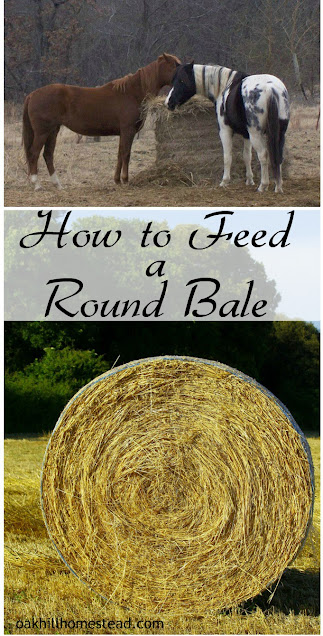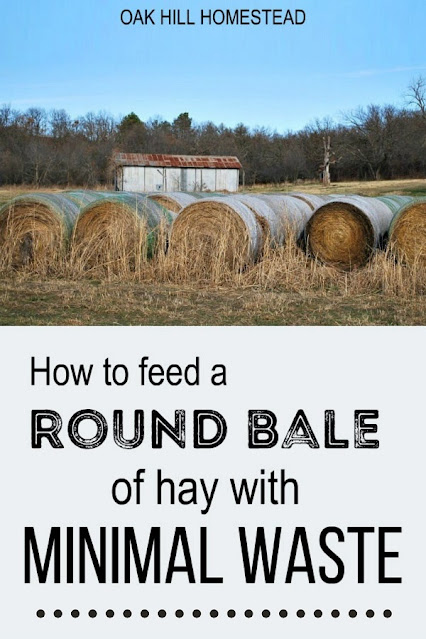Feeding round bales to your homestead livestock? With just a few animals, feeding round bales by hand means less waste. These tips will help you reduce hay waste and save money.
How to feed a round bale with less waste
If you're a livestock owner, you know that feeding hay is a crucial part of your animals' diet in the winter. But if you're feeding round bales, you may also know that it can be tough to prevent waste.
Over the years, we have tried various methods to feed round bales to our horses and goats without wasting hay. Here are the tips and tricks we've learned to minimize waste and to keep your horses and goats well-fed.
Feeding round bales
We are no strangers to drought here in Oklahoma.
Some years we have plenty of rain in spring and summer and have a good hay crop - sometimes the farmers can even get a second cutting of hay.
Other years we aren't so fortunate and hay is expensive and sometimes hard to come by. One year hay was trucked to Oklahoma from other states and we were very thankful that those farmers were willing to help us out.
For several years we cut and baled our own hay by hand. After that our neighbor baled it on shares - in other words, he put in the work with his equipment and in return he kept 60% of the round hay bales.
Which left us with 40% of the hay crop - a nice return for letting him cut and bale our hay.
Square bales vs round bales of hay
Hay bales come in different sizes and shapes.
There are small square bales, the only kind I was familiar with before moving here. There are round bales, and bigger round bales, and large square bales that are usually 3'x3'x8' - not really square, but then again, small squares aren't square either.
Small squares are the easiest to store because they stack so well. They are easy to put on the pickup truck to bring home. They are easy to open and easy to feed. Just pull off a "flake" of hay and drop it in the feeders and you're done.
Of course if you raise cattle or have a lot of horses, small squares aren't as easy to feed, and surely not the most economical. In fact, small square hay bales are the most expensive.
Large square 3'x3'x8' bales are being offered for sale more and more here in our area. They are relatively easy to feed: you pull off a 3' x 3' flake.
Most people then break the big flakes into smaller hunks and that's where "easy" ends.
These large square bales stack well for storage IF you have a tractor to stack them with. One will fit in a pickup IF you have an eight-foot-long truck bed, and IF you have a tractor to load it with (most places you buy them from will load it for you).
It's not so easy to get a large square bale out of the truck when you get home. A friend of mine says she ties the bale to a tree and then drives the truck out from under it. Of course, once it's on the ground it's not going anywhere else, and we don't have any convenient trees like that.
Round bales are more economical than small square bales, especially if you have more animals to feed. Round bales are the most widely available here in Oklahoma.
You can plop it in the pasture, cut the strings, and let the horses or cows or goats eat at will.
It's easy. It lasts longer so it's less work. The feed store will load one into your truck for you.
Unloading a round bale is easier than a large square bale, and the Chief enjoys this part.
He backs up to approximately where he wants the bale to land, stops, drops the tailgate of the truck, then stomps on the gas pedal and pulls forward rapidly so the bale rolls out.
Sometimes it takes a few tries, which is even more fun.
But we have goats, and goats take forever to finish up a round bale.
They climb on top of it, poop on top and then refuse to eat the soiled hay (not that I blame them for not wanting to eat soiled hay, but sheesh they could practice better hygiene).
And horses aren't neat eaters either. The hay slides off the top of the bale to the ground. The horses stand in it, strew it around, step on it, sleep on it, and poop on it.
There is a lot of waste when you feed round bales directly - no matter what kind of livestock you feed it to - so I've learned how to peel the hay off of the round bales and feed it by hand.
How to feed a round bale and minimize waste
Unload the hay in a place your animals can't get to, not out in the pasture.
Set the round hay bale on the round side, not the flat end. This is how a bale usually lands when it parts company from the pickup, however, it will occasionally teeter and fall over.
If that happens, it will take at least two people to get it back on its side again.
Remove the strings or netting. Remove the top layer of hay, which is often spoiled by the weather and must be discarded.
You can put this spoiled hay on the compost pile or on top of your resting-for-the-winter garden, but be aware that if there are weed seeds in the hay, they will end up in your garden soil.
Then peel the hay in layers off the top of the bale, getting as close to the ground on the sides of the bale as you can, as much hay as you need at each feeding.
You'll only be able to remove "so much" of it at the bottom, and eventually you'll end up with the middle of the bale sitting in a "cradle" of hay.
The hay that I've peeled off is what I feed my animals. I fill the goats' feeders with it, and the horses each get a large pile of it on the ground. A pile for each horse, that is, so that the "bully" can't hog it all.
Too much work? Well, yes, it's work, but we only have a couple of horses and half a dozen goats at this point. It takes a really long time ofr them to finish a round bale of hay, and over half of it would be wasted.
Do you know how much money I save because I don't need a gym membership? This is better than lifting weights! (My son-in-law once said he'd hate to meet me in a dark alley.)
I throw a tarp on top of the hay bale once I've "opened" it to help keep it dry in the event of rain or heavy dew.
Now you can try to push the middle of the bale out, pushing from one side, so that it is parted from the cradle and ends up on the ground.
Sometimes it's still too heavy for me to budge, and I might have to work at it for a few days to get it to the point of being moveable. But that's ok, I just keep peeling hay off the top and feeding my hungry animals.
Once you get the middle of the bale - the "core" - on the ground, you can remove hay from the cradle as needed. It's really easy to get as much hay as you need for each feeding when you get to this stage.
And then you're left with the core of the hay bale.
I push the core around the yard, so that it unrolls on the ground. I pick up the unrolled layer of hay off the ground, add it to my wheelbarrow and feed it to my livestock.
I push the core a ways further, pick up and feed the hay, roll the core back up to where I started, and roll it out again, feed that hay, roll it back to the starting point again, back and forth, repeating as needed.
And finally comes the day when I give the horses the very middle of the bale and they snack all day till it's gone. Time to open a new bale.
As a goat lover and a homestead gardener, I'm excited to share my gardening tips with you too - from planting seeds to enjoying the fruits (and vegetables) of your labor! You can find my gardening advice and insights right here, so let's dig in and cultivate some fresh, delicious produce together.



















